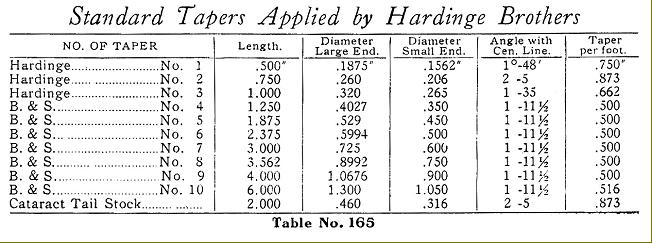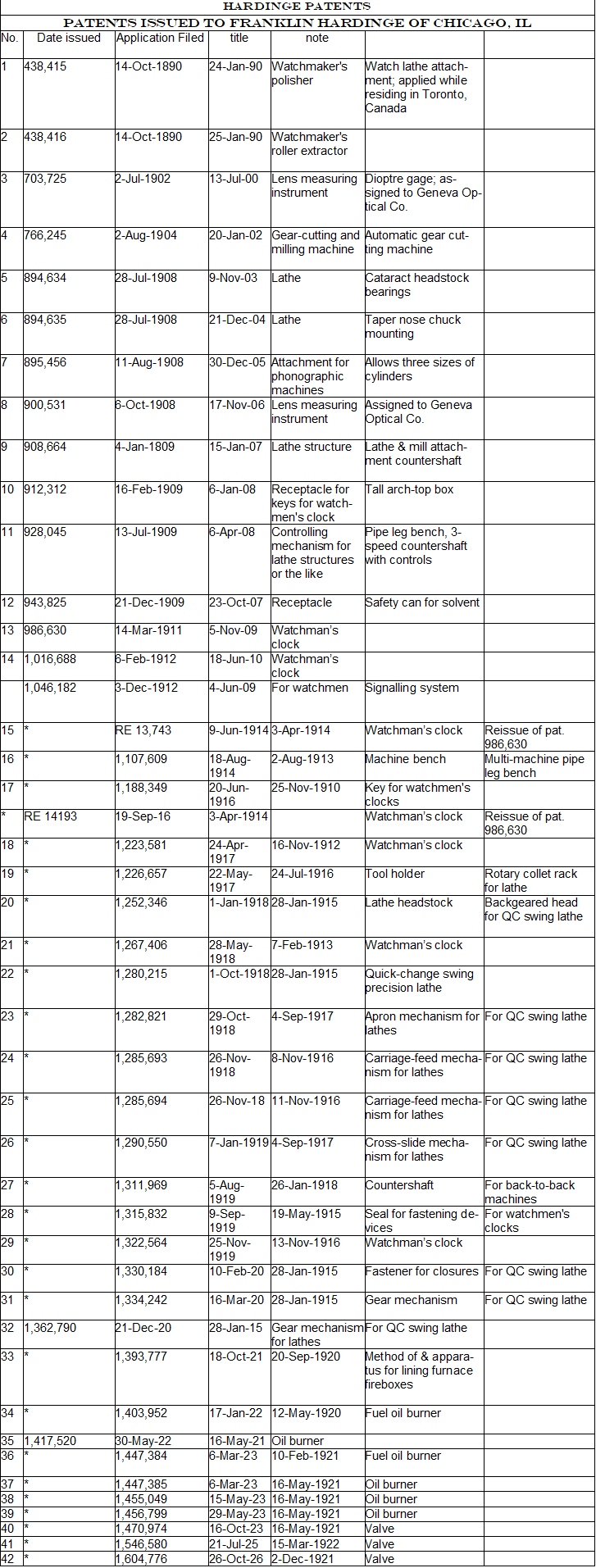|
Natives of Canada, the brothers Hardinge, Henry (1863-1947) and Franklin (1867-1945) were both life-time engineers. Henry began his career as a machinist with the John Abell Company of Woodbridge in Ontario, a maker of portable engines and farm threshing devices. He then travelled to the United States, working at various jobs until he was taken on as a draftsman by a Chicago firm where is brother was already employed as an apprentice; Franklin, however, served only two years of his time before leaving to continue his studies with a local watchmaker.
Thanks to the ever-increasing use of on-line family history guides, it is now possible to trace the Hardinge family history back a little further, with Franklin having (2013) a living daughter and several grandchildren. In 1956 Franklin's sister Charlotte (1871-1958) wrote an interesting story about her parents and her thirteen siblings: their father had been an English gentleman with the misfortune to have a dissolate elder brother; however, his mother still managed to leave him sufficient money to fund a move to Canada and the purchase of a farm - hence the Canadian births of both Franklin and Henry (known in the family as Frank and Harry). A history of the family can be found here - clicking on the various family members brings up a number of interesting details.
After completing his indentures Franklin joined his bother in their first business venture, on 23 July 1890, as Hardinge Brothers making watchmakers' tools in an eight-by-eight building at the rear of a boarding house at 359 West Monroe Street, Chicago. Driven out of their inadequate premises by cold weather the two brothers found a backer in the form of a Mr. Stephen R. Dale and founded a firm known as The Horological Tool Company that operated from what could have been a hardly more salubrious room over a horse stable at 1230 Dunning Street (later Altgeld Street). However, by May 1892 the Hardinge Company were doing well enough to afford the erection of a small factory at 3135 Lincoln Avenue - where they remained until 1913 - before moving to new and larger premises at 4149 Ravenswood. Avenue, Ravenewood. In 1894 Mr. Dale had withdrawn his interest in the company and the two bothers reverted to their original title of Hardinge Brothers; however, just one year later, in 1895, Henry retired from the partnership (though what prompted this move is unknown) and Franklin continued on his own until 1908 when the company was incorporated for $100,000 under the laws of Illinois. In 1902 (or thereabouts) Hardinge acquired the rights to the Cataract range of Precision bench lathes formerly produced by the Cataract Tool and Bicycle Company (named after the waterfalls visible from the factory grounds) and the Cataract Tool and Optical Company the latter being incorporated in Buffalo (New York) and probably, in reality, not a separate Company but part of Tool and Bicycle. The story is a little more complicated in that, in order to acquire rights to the company's rifle scopes, the Cataract enterprise was originally bought out in 1902 by the well-known gun and tool maker J. Stevens Arms & Tool Company, of Chicopee Falls, Massachusetts. Stevens, who employed the skills of former Cataract manager Mr. F. L. Smith, continued to market the scopes under their original name but, shortly afterwards passed the machine-tool side of the business on to Hardinge Brothers. The first catalog of the newly acquired organisation was issued in 1903 and, under a Hardinge heading, showed the Company's first "Cataract" branded bench lathe.
Franklin was to obtain several patents relating to aspects of his lathes and milling machines during the period 1909 to 1920 with, in addition, several relating to oil furnaces dated from 1921 to 938. Furnace patents issued from 1930 to 1936 were assigned to Hardinge Brothers Inc. (probably indicating that the furnaces were built by the same company that made the lathes) but with patents thereafter (from 1936 onwards) assigned to the inventor himself.
During the early years of the 20th century, after the acquisition of the Cataract concern, the organisation continued to grow and, in 1913, a further move was made to 1770 Berteau Avenue, though administrative offices were retained at the Ravenswood Avenue site. At around the same time that Hardinge were settling into Ravenswood, a small company was being established in Rochester, New York, by Mr. Reisinger and Mr. McDonnell, to exploit the growing market for precision work-holding devices, especially collets. The new company's unique selling point was their "Inanout" collet, a design that unfortunately proved inadequate under service conditions and was abandoned; however, the awkward name stuck, and the "Inanout Collet Manufacturing Company" was born. Franklin was an accomplished engineer, machine-tool designer and inventor and contributed to work on a calculating machine for Remmington, helped the Stromberg Carlson Company with their early developments on automatic telephones systems and developed the "scoring" machine that perforated card so that it could be easily torn where needed.
Continued below:
|
|

